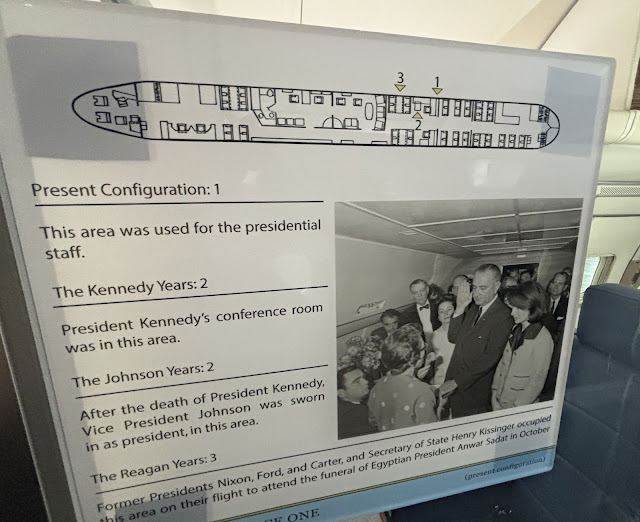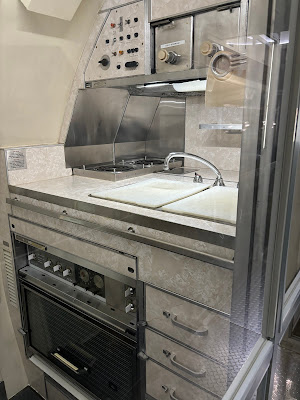We had one last stop before we left Dayton - the National Museum of the United States Air Force. Since 1923, the museum has grown from a small engineering study collection to the world's largest military aviation museum. Today, the museum collects, researches, conserves, interprets and presents the Air Force's history, heritage and traditions.
We'd received a "tip" that when entering, we should walk to the rear of the museum in order to see the Presidential Gallery so we bypassed the exhibits in order to take the tour in reverse.
The centerpiece of the collection is SAM 26000, a modified Boeing 707, used regularly by presidents John F. Kennedy, Lyndon Johnson, and Richard Nixon. It became the backup presidential aircraft after Nixon's first term.
SAM 26000 bears a connection to one of the nation's greatest tragedies, a moment that forever altered the course of American history. On November 22, 1963, President Kennedy was assassinated while traveling through downtown Dallas. Hours later, Vice President Lyndon Johnson was sworn in as the new president aboard SAM 26000. The aircraft then carried Kennedy's body and President Johnson back to Washington, DC, and a grieving nation.
For those of - ahem - a certain age, we will remember that day forever.
You can see the configuration of the plane on November 22, 1963 above
We were able to walk through the plane.
There were several other important air craft on display.
The Columbine III served as President Eisenhower's personal airplane from 1954 until he left office in January, 1961. A military version of the famous Lockheed L - 1049 Super Constellation commercial airliner, it has a fuselage "stretched" eighteen feet longer than earlier versions. With more powerful engines, greater fuel capacity, and greater speed, these aircraft were popularly known as "Super Connies."
Eisenhower named this aircraft, his third Constellation, Columbine III, after the official state flower of Colorado in honor of his wife, Mamie. An adopted daughter of the state, Mrs. Eisenhower formally christened the Columbine III on November 24, 1954, with a splash of water from Colorado instead of the traditional bottle of champagne. Immediately afterward, Columbine III carried the President, the First Lady, and British Field Marshall Viscount "Monty" Montgomery to Augusta, Georgia, for a five day golfing vacation over the Thanksgiving holiday.
After President Eisenhower left office, the US Air Force continued to use Columbine III as a VIP transport. The aircraft was retired from service in April, 1966 and flown to the Museum for permanent display.
The Independence, a Douglas VC-118, was the second aircraft built specifically to transport the President of the United States. A military version of the Douglas DC-6 commercial airliner, it was used by President Harry Truman from 1947 to 1953. At the suggestion of the aircraft's pilot, President Truman named it "The Independence" in recognition of his hometown, Independence, Missouri. One of the plane's most historic flights occurred in October, 1950 when it carried President Truman to Wake Island to discuss the Korean War situation with Gen Douglas MacArthur.

In 1966, the US Air Force purchased a standard Beechcraft King Air B90 with a special VIP interior, designated as the VC-6A, to support President Lyndon Johnson and his family. The aircraft was faster and more agile than other light transport aircraft and featured full pressurization for comfort at high altitude. Other special features included all-weather navigation, de-icing equipment, and reversible propellers that allowed the aircraft to land on very short runways.
The VC-6A was primarily used to transport the President and his family between Bergstrom AFB, Texas, and the Johnson Ranch near Stonewall, Texas. Owing to these frequent flights, the aircraft became informally known as the "Lady Bird Special", a play on the childhood nickname "Lady Bird" of First Lady Claudia Johnson.
The Memphis Belle was a B-17F heavy bomber assigned to the 324th Bomb Squadron, 91st Bomb Group, at Bassingbourn, England, during the early part of the USAAF strategic bombing campaign. Between November 1942 and May 1943, the Memphis Belle and its crew flew 25 bombing missions, including strikes against targets in Germany, France, and Belgium. At the time, the odds of completing a 25-mission tour and going home were small. During the Memphis Belle's tour, the Eighth Air Force averaged one bomber lost every 18 sorties (one sortie equals one aircraft flying one combat mission).
Although the Memphis Belle was damaged on several combat missions, the crew beat the odds and completed their 25th mission on May 17, 1943. The crew then returned home for a war bond tour across America.
The C-20B (civilian designation Gulfstream III) provided executive airlift to thousands of senior American leaders for more than two decades. During its long service, this aircraft carried President Clinton and former Presidents Jimmy Carter, Gerald Ford, and George H.W. Bush. It also carried presidential spouses, several secretaries of state and defense, foreign dignitaries, and numerous high-ranking civilian officials and military personnel.
On July 12, 1957, President Eisenhower became the first chief executive to fly in a helicopter when he lifted off from the White House Lawn in the sister ship of this Sioux on display. In 1958, the U.S. Army and U.S. Marine Corps took over the presidential helicopter mission while the USAF retained responsibility for transporting the president in fixed wing aircraft. Since 1976, the Marine Corps has operated all presidential helicopters.
We spent a lot of time in this area and the day was getting away from us. I swear you could spend two full days in this museum and still not see it all. A few more interesting things on the way out.




A very somber exhibit was "Prejudice & Memory: A Holocaust Exhibit" is made up of photographs, artifacts and memories of people who now live in the Dayton area. Among the contributors are concentration camp survivors and their families, liberators, and "righteous Gentiles" (non-Jews who helped Jews during the Holocaust).
It is one of the few such exhibits in the country compiled to demonstrate one community's connection with the terrible event and to affirm the belief that learning about the Holocaust is the first step toward preventing its recurrence. I fear we are seeing that the country needs a lot more education :-(
It ripped my heart to see the items.
Perhaps the rarest artifact in the exhibit is this concentration camp uniform which is one of very few still in existence. It was given to the museum by Jack Bomstein, whose father, Moritz, wore the uniform while he was imprisoned at Buchenwald. Allied Prisoners of War interned at Buchenwald in 1944 had their military uniforms taken away and they, too, were forced to wear uniforms similar to this one.
The United States Air Force (USAF) was originally created in 1907 as part of the US Army Signal Corps. The USAF was established as a separate branch of the United States Armed Forces in 1947 and is the second youngest branch of the United States Armed Forces.
The direct predecessor of the USAF was the United States Army Air Forces (USAAF or AAF) which was the de facto aerial warfare service branch of the United States during and immediately after World War II (1941-1947). My dad served in the USAAF from 1946-1947 so it was interesting to see this display.
All of the exhibits were overwhelming with so much to see and we were wearing out. I'm glad we took the tip to visit the Presidential Gallery first. But before we left, we took a peek at the space exhibit.

And I found a special uniform to model.
Of course there was an exhibit featuring the Wright Brothers - we were in Dayton after all!
The Wright 1909 Military Flyer became the first military heavier-than-air flying machine. Upon purchase by the Signal Corps for $30,000 on August 2, 1909, the US Army designated the Military Flyer as Signal Corps Airplane No. 1, and it remained the only Army airplane for nearly two years.
In October 1909, Wilbur Wright used Signal Corps No. 1 to give flight instruction. In 1910, Lt. Benjamin Foulois taught himself how to fly in Signal Corps. By 1911, after several crashes and repairs, the Army retired Signal Corps. No. 1 and it is now on exhibit at the National Air and Space Museum in Washington, D.C.
This airplane on display is an exact reproduction constructed by museum personnel in 1955. It is equipped with an engine donated by Orville Wright and chains, sprockets and propellers donated by the heirs of the Wright estate.
And that was it. If you have an opportunity to visit the National Museum of the Air Force, you won't be disappointed.






























I can't comment on my phone where I can dictate and my broken wrist makes typing difficult so this and future comments will be short! Why is the Holocaust exhibit in the air force museum?
ReplyDelete